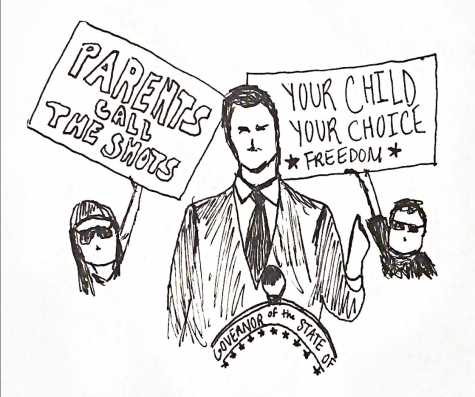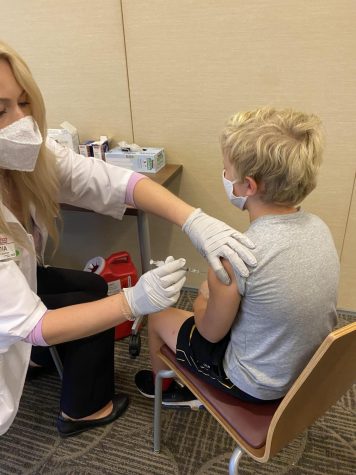Omicron: What You Need To Know
After a well-deserved break, Bishop’s students came back on campus but the Omicron made the return a bit different. According to the Knights News published on January 9th, 2022, 46 out of 761 employees and students tested positive for COVID-19 as of January 6th, so here are 5 things you need to know about the new variant.

When was Omicron first reported?
Omicron, or B.1.1.529, is a variant of COVID-19 that was reported to the World Health Organization from South Africa on November 24th, 2021, according to the CDC. The first detection of Omicron was in samples collected from Botswana on November 11th, 2021 and the first case in the US was detected on December 1st, 2021.
Why have scientists been concerned about Omicron?
The high degree of transmissibility has been under a high degree of concern for scientists and people alike. One example was a party in Oslo, Norway during late November. 70% of partygoers were infected with Omicron from one person who was carrying the virus after traveling to South Africa.
According to NPR, Omicron’s high transmissibility is caused by mutations that allow it to infect human cells more efficiently than previous variants could. Science teacher Dr. Pelletier states that “There are more breakthrough infections so that supports the idea that the immune system is not as good at defending against Omicron even after vaccination.” A study by Denmark published on December 27th, 2021, stated that the Omicron variant “is generally 2.7-3.7 times more infectious than the Delta [variant] among vaccinated individuals.” The same study also found that the transmissibility of Omicron compared to Delta within a family, household, dormitory or dwelling unit was 1.17 times higher for unvaccinated individuals, 2.61 times higher for fully vaccinated individuals and 3.66 times higher for boosted individuals.
The high infection rate for even vaccinated and boosted individuals has brought to light Omicron’s immune evasiveness, or its ability to bypass the immune system.
How effective are vaccines against Omicron?
Though the vaccines are less effective against Omicron compared to previous variants, a study by Denmark found that vaccine effectiveness for Omicron is still around 40% against symptoms and 80% against severe disease. Dr. Pelletier states “It appears as though people who are vaccinated are having fairly mild symptoms.” The same study also found that booster vaccines had 86% effectiveness against symptoms and 98% against severe disease. According to the New England Journal of Medicine, there was a maintenance of effectiveness for the Pfizer vaccine against hospital admission for COVID-19 for cases presumed to be Omicron, compared to the Delta variant.

What’s the incubation period of Omicron?
Eurosurveillance, a medical journal on infectious disease surveillance published by the European Centre for Disease Prevention and Control, conducted a study on the Oslo party and found that the incubation period of Omicron could be around 3 days, while the incubation period for the Delta variant is around 4.3 days. A study by the CDC also found the incubation period for Omicron to be around 3 days.
How is Omicron affecting Bishop’s?
Mr. Beamer, Assistant Head of School, stated that “what Bishop’s has going for it is that it’s a highly vaccinated community.” Data has pointed to the fact that Omicron is less severe for vaccinated populations. A study published by the Washington State Department of Health on January 19th, 2022 found that 12-34 year-olds that were unvaccinated were 2 times more likely to get COVID-19 compared to fully vaccinated 12-34 year olds. The same group of people were also 5 times more likely to be hospitalized with COVID-19 in comparison to vaccinated 12-34 year olds. A similar trend was seen with 35-64 year olds and 65+ year olds where the likelihood of getting COVID-19 for the unvaccinated was 3 times higher and 4 times higher respectively. For hospitalization, unvaccinated 35-64 year olds were 8 times more likely to get hospitalized and 65+ year olds were 7 times more likely to be hospitalized.

Though the study by the Washington State Health Department does not specify which variant the people were infected with, statistics released by the CDC found that, as of January 4th, 95.4% of all COVID-19 cases were of the Omicron variant.
According to AFP news, a preliminary US study of around70,000 patients found that “people infected with Omicron were half as likely to be hospitalized, about 75 percent less likely to need intensive care, and around 90 percent less likely to die compared to those infected with the formerly dominant Delta variant.” In fact, the median number of hospital days for Omicron was 1.5 days, compared to the Delta variant’s 5 days.
Conclusion
Mr. Beamer states “The evolution of viruses tends to be that the more they evolve, the more transmissible they become but the less severe they become.” He also added, “It’s a pain in the neck, but people die in much smaller numbers and people go to the hospital in much smaller numbers.” With people getting COVID-19 with milder symptoms it seems like Omicron may be creating a shift in the pandemic for the better.

Kayden came to Bishops in 8th grade and became a staff writer for The Tower this year. He joined The Tower since he wanted to improve his writing, learn...











